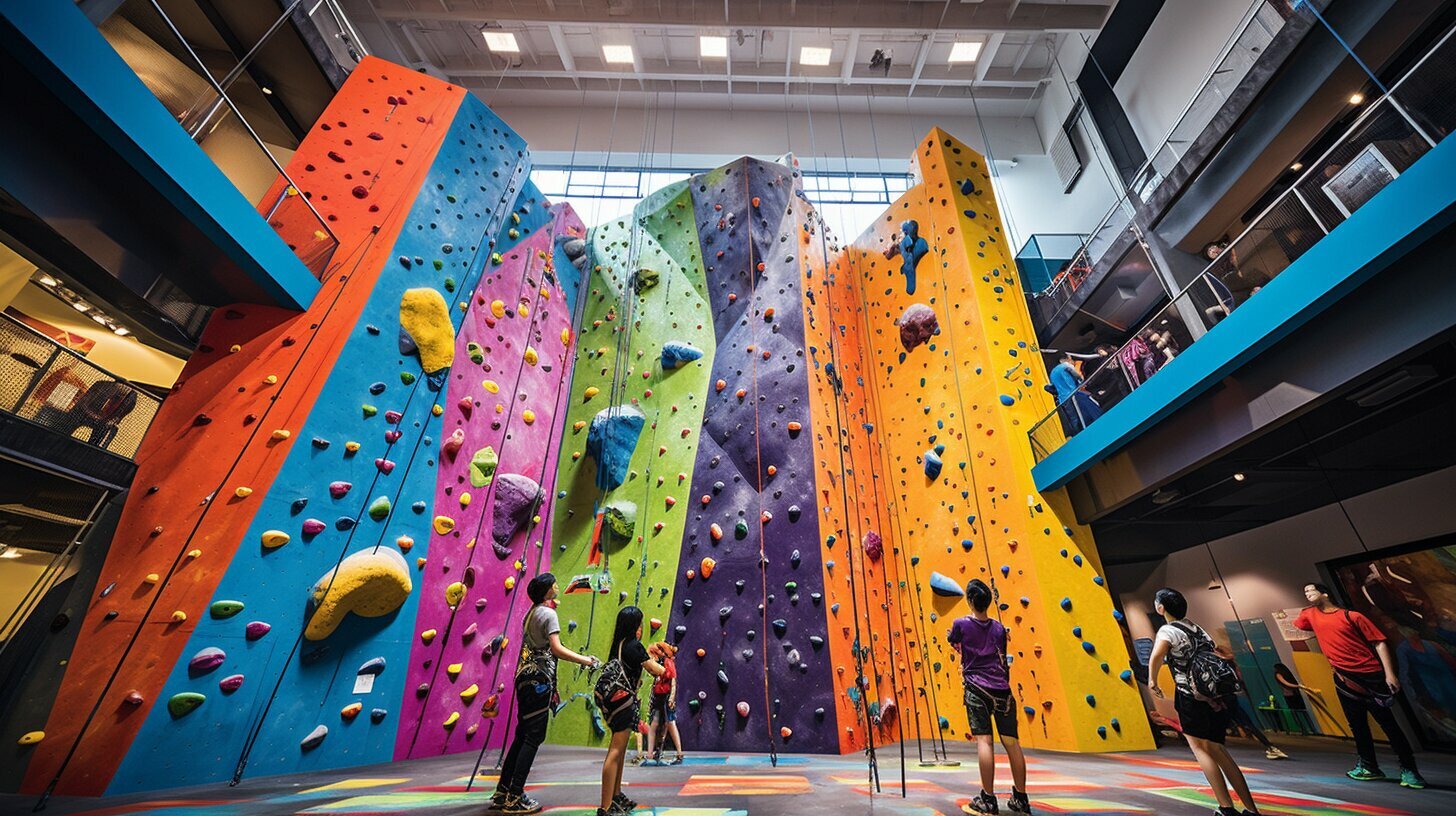Are you ready for a new adventure? Indoor climbing could be the perfect activity for you! Not only is it a fun way to challenge yourself physically, but it also offers a unique mental stimulation that can be very rewarding. This guide is designed to help beginners get started with indoor climbing, whether you’re looking for a new hobby or want to improve your fitness level. In this guide, we’ll cover everything from essential gear, safety tips, and climbing techniques to indoor climbing exercises, classes, and more.
Key Takeaways
- Indoor climbing is a fun and challenging activity for beginners
- It offers many physical and mental benefits
- This guide will cover the essentials of indoor climbing for beginners
- We’ll provide tips on gear, safety, techniques, and more
- With this guide, you’ll be ready to start your indoor climbing journey
Why Choose Indoor Climbing as a Beginner?
Are you new to climbing and looking for a beginner-friendly way to get started? Indoor climbing is an excellent option for those just starting out. Here’s why:
- Controlled Environment: Indoor climbing gyms offer a controlled environment for beginners to learn and practice climbing techniques. The gym setting allows for a variety of routes at various levels of difficulty, so you can progress at your own pace.
- Safety Measures: Indoor climbing gyms have plenty of safety measures in place to keep you safe. At the very least, staff members will be available to teach you how to use equipment properly and provide belaying assistance.
- Beginner-friendly: Many indoor climbing gyms offer classes and instructional sessions specifically designed for beginners. These classes are a great way to learn the basics and build a solid foundation for your climbing skills.
If you’re new to climbing, there are a few tips to keep in mind to make your experience a positive one:
Disclosure: When you buy through links on our site, we may earn an affiliate commission.
- Start at an Easy Level: Choose a route that’s easy enough for you to complete successfully. As you progress, you can move on to more difficult routes.
- Use Proper Technique: Good technique is essential for climbing well and avoiding injuries. Be sure to use proper footwork, handholds, and body positioning as you climb.
- Take Breaks: Climbing can be physically demanding, especially when you’re just starting out. Take breaks as needed to prevent fatigue and reduce your risk of injury.
By choosing indoor climbing as a beginner, you’ll have the opportunity to learn from experienced climbers in a safe, supportive environment. Ready to give it a try? Let’s get started!
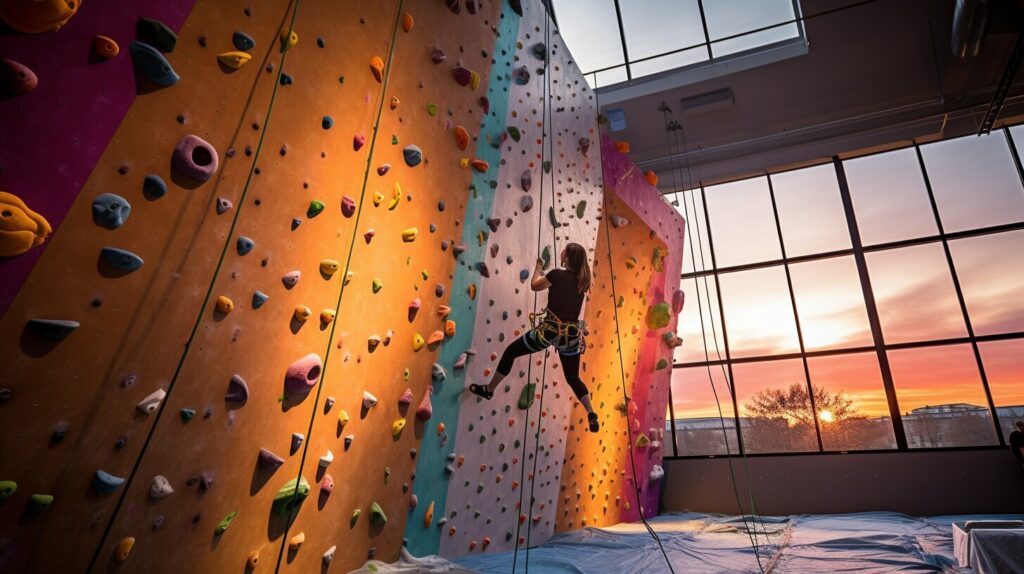
Essential Gear for Indoor Climbing
When starting indoor climbing, having the right gear is essential for both safety and comfort. Here are the basic items you’ll need:
| Item | Description |
|---|---|
| Climbing shoes | Specialized shoes designed for traction, comfort, and precision. |
| Harness | Attaches to the climber and allows for connection to safety ropes. |
| Belay device | A mechanical device that provides friction for the rope during belaying. |
| Chalk bag | Used to keep hands dry and improve grip on holds. |
| Helmet | Protects the head from potential falls or impacts from other climbers. |
It’s important to note that not all climbing gyms require climbers to bring their own gear. Many gyms offer gear rentals or include gear in beginner packages. However, if you plan to climb regularly, investing in your own gear may be more cost-effective in the long run.
When purchasing gear, it’s crucial to ensure proper fit and sizing for maximum safety and effectiveness. Visit a climbing specialty store or seek advice from experienced climbers for guidance.
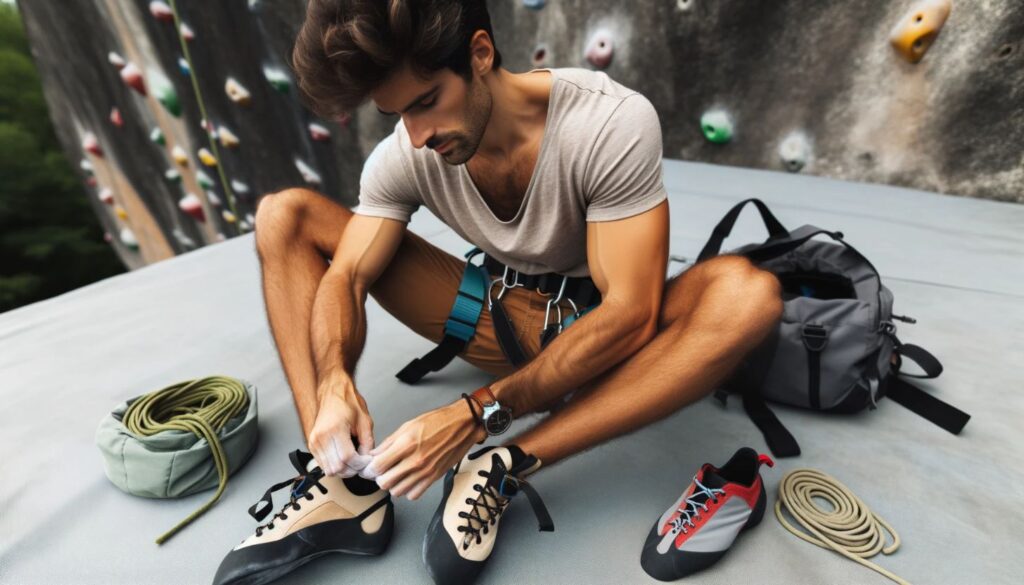
Remember, safety is paramount in climbing. Always double-check gear before climbing, follow gym rules and guidelines, and never climb alone without a certified partner. With the right gear and precautions, indoor climbing can be a fun and rewarding activity for beginners.
Choosing the Right Indoor Climbing Gym
Choosing the right indoor climbing gym is essential to get the best experience as a beginner. Here are a few factors to consider:
| Factors to Consider | What to Look for |
|---|---|
| Location | Choose a gym close to you for convenience. |
| Facilities | Check if the gym has all necessary facilities like showers, lockers and yoga rooms to make your experience comfortable. |
| Routes | Look for a gym that offers multiple routes for all skill levels including dedicated beginner routes. This will help you progress as you gain more experience. |
| Instructional Offerings | Check if the gym offers classes or instruction for beginners. These can include group classes or one-on-one instruction with experienced instructors. |
Here are some of the best indoor climbing gyms for beginners:
- Brooklyn Boulders: With locations in several cities across the US, Brooklyn Boulders is known for its beginner-friendly environment and supportive community.
- Planet Granite: With a focus on safety and technique, Planet Granite offers classes and events for climbers of all skill levels.
- Central Rock Gym: With multiple locations in Massachusetts, Connecticut, and Rhode Island, Central Rock Gym offers a variety of routes and classes for beginners.
Remember, finding the right gym can be an important part of your climbing journey. Take the time to research and visit different gyms until you find one that works for you and your goals!
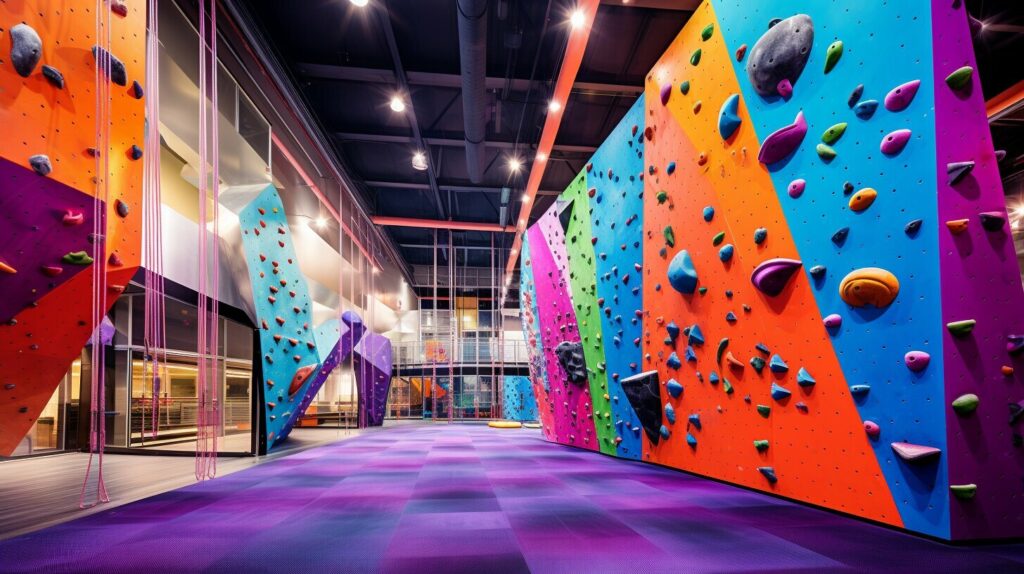
Safety Tips for Indoor Climbing
Indoor climbing is a safe and fun way to start your climbing journey, but it’s important to always keep safety in mind. Follow these safety tips to ensure a safe and enjoyable climb:
- Warm-up and stretch: Before starting your climb, spend at least 10 minutes warming up and stretching all major muscle groups. This will help prevent injury.
- Check equipment: Always double-check your harness, shoes, and rope/belay device before climbing. If you notice any damage or defects, do not use the equipment and notify staff immediately.
- Communicate: Proper communication between the climber and belayer is crucial. Be sure to confirm signals and commands before starting your climb.
- Watch for other climbers: Be aware of your surroundings and watch for other climbers on nearby routes. Never cross or climb over someone else’s rope.
- Practice falling: Falling is a normal part of climbing, but it’s important to know how to do it safely. Practice falling onto the mat to get comfortable with the movement.
Remember, safety is always the top priority in indoor climbing. Follow these tips to ensure a safe and enjoyable climb.
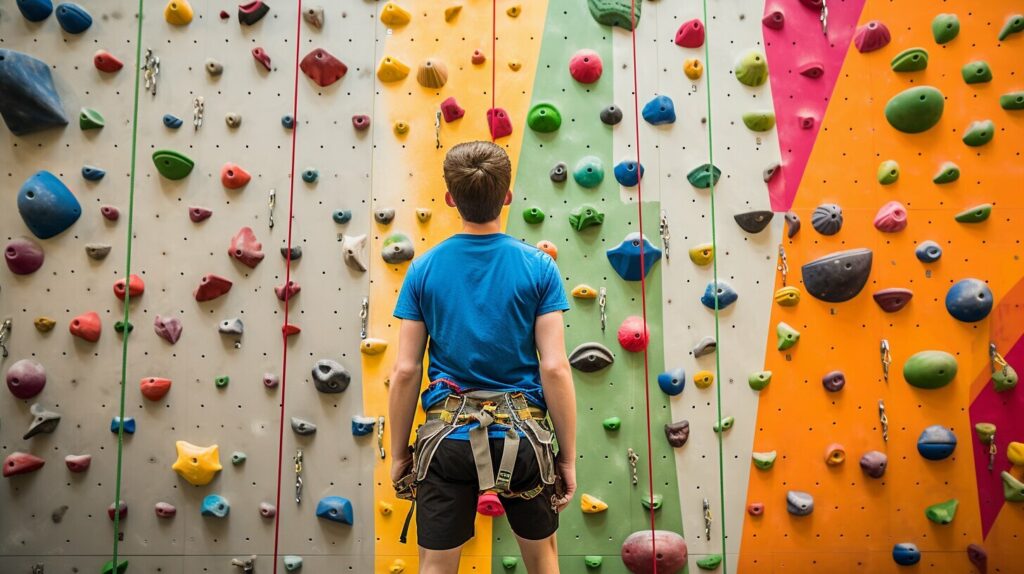
Climbing Techniques for Beginners
Learning the proper techniques for indoor climbing is important for both safety and enjoyment. As a beginner, it’s essential to start with the basics and build a strong foundation.
Here are some indoor climbing techniques for beginners to keep in mind:
- Focus on good footwork: Proper foot placement is key to maintaining balance and conserving energy. Keep your weight over your feet and use the edges of your shoes to grip the holds.
- Use your legs: Your leg muscles are much stronger than your arms, so use them to push yourself up the wall. Keep your arms straight to save energy and avoid getting pumped.
- Engage your core: Your core muscles help stabilize your body and keep your balance. Practice keeping your body close to the wall and engaging your core to maintain good form.
- Look for natural resting positions: Resting on a good hold or ledge can give your muscles a break and allow you to catch your breath before continuing.
Practice Makes Perfect
Remember, practice is essential to improving your climbing skills as a beginner. Take the time to learn proper techniques and build your strength and stamina gradually. Start with easy routes and progress to more challenging ones as you improve. With consistent practice, you’ll soon be a competent and confident indoor climber.
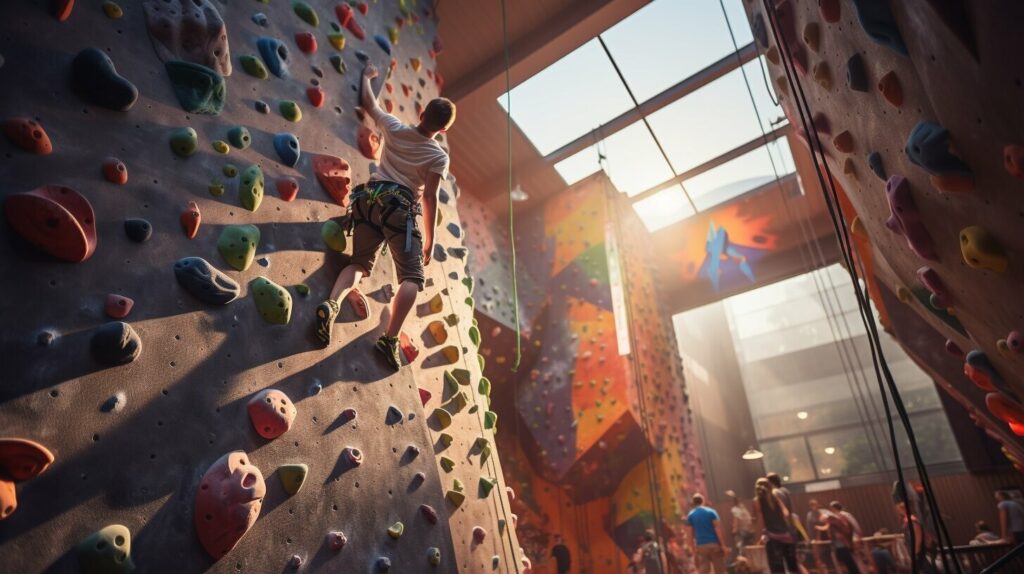
“Climbing is not about standing on top, it’s about getting there safely. Never forget that.” – Bear Grylls
Indoor Climbing Routes
When it comes to indoor climbing for beginners, it’s important to choose routes that are appropriate for your skill level. Indoor climbing gyms typically offer a range of routes, from easy to challenging, that are labeled with a grading system. For beginners, it’s recommended to start with routes that are rated between 5.5 and 5.8.
Routes with a 5.5 rating are considered the easiest, featuring larger holds and straightforward movements. As you progress, you can try routes with slightly higher ratings, such as 5.6 or 5.7. These routes may have smaller holds or require more advanced techniques. It’s important to challenge yourself, but also to know your limits and not attempt routes that are too difficult.
When selecting routes, it’s helpful to observe other climbers and ask for recommendations from staff or more experienced climbers. You may also want to try different types of routes, such as slab, vertical, or overhang. These will introduce you to different techniques and styles of climbing.
Remember to take breaks and rest as needed, especially if you’re feeling fatigued or experiencing muscle soreness. Climbing can be physically demanding, but with proper technique and pacing, you can build strength and endurance over time.
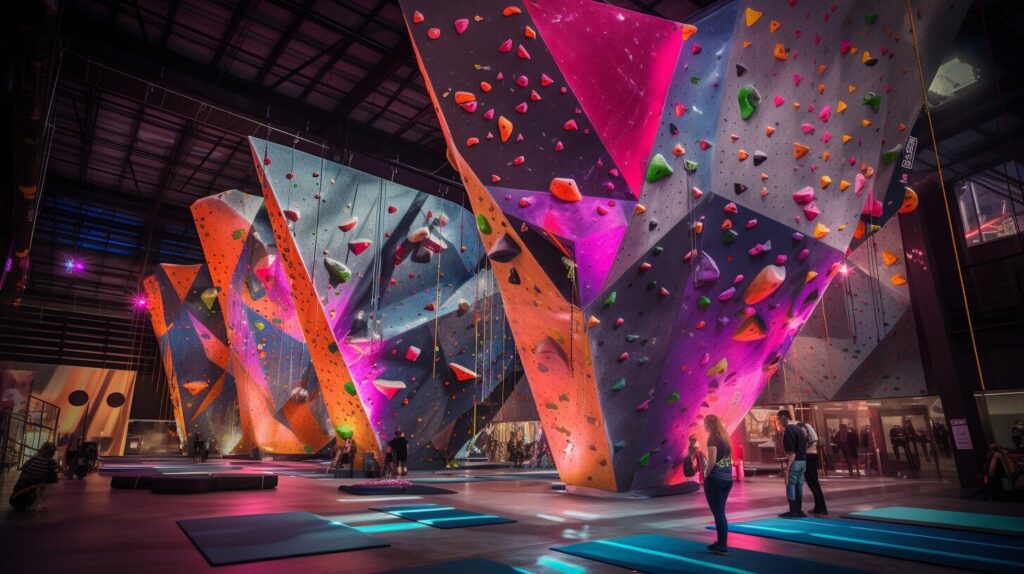
Indoor Climbing Classes for Beginners
Indoor climbing classes provide an excellent opportunity for beginners to receive expert instruction, develop their skills, and meet other climbers. There are various types of classes available, including intro classes, technique-focused classes, and bouldering-specific classes.
When choosing an indoor climbing class, consider your goals and fitness level. Intro classes are designed for those with no climbing experience, while more advanced classes are geared toward climbers looking to improve specific skills.
Most classes will cover climbing basics such as equipment use, safety techniques, and body positioning. Technique-focused classes may provide more in-depth instruction on specific movements and skills, while bouldering classes may focus on developing strength and problem-solving abilities.
Classes are typically led by experienced instructors who can provide personalized guidance and feedback. They can also offer insights on training programs, injury prevention, and how to progress in the sport.
As with any physical activity, it’s important for beginners to start slowly and build up their skills and strength gradually. Attending a class can provide a safe and supportive environment to do so.
Many indoor climbing gyms offer classes for beginners, and some may even provide discounts or package deals for multiple sessions. Check with your local gym to see what options are available and start your journey to becoming an indoor climbing pro today!
Class Types
Here are some of the most common types of indoor climbing classes for beginners:
| Class Type | Description |
|---|---|
| Intro to Climbing | A class designed for those with no climbing experience. Covers basics such as equipment use, safety, and etiquette. |
| Technique-focused | A class that provides in-depth instruction on specific climbing movements and skills. Ideal for those looking to improve their technique. |
| Bouldering-specific | A class focused on developing strength and problem-solving abilities for bouldering. Ideal for climbers looking to improve their bouldering skills. |
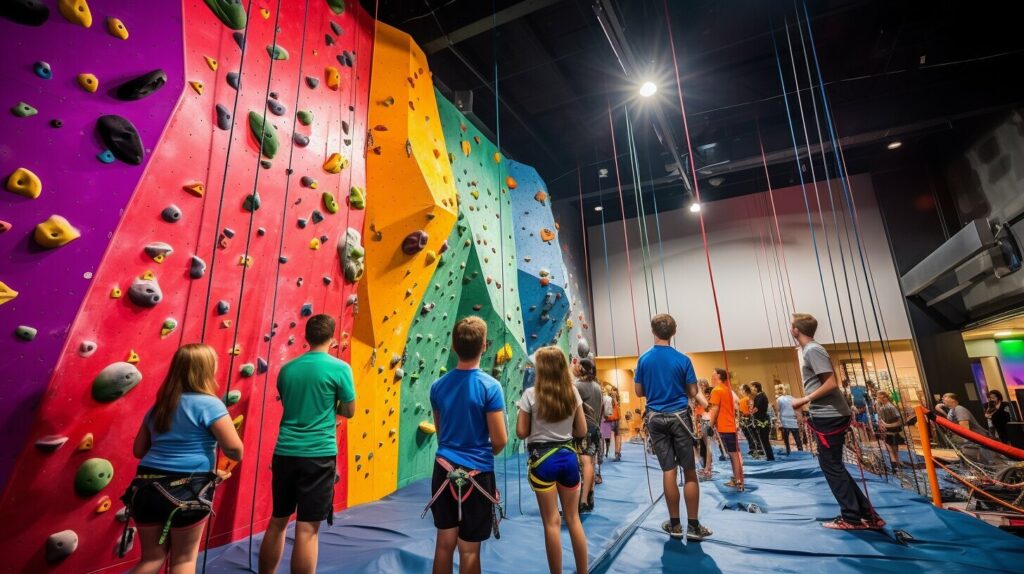
Take an indoor climbing class to receive expert instruction, develop your skills, and meet other climbers.
Indoor Climbing Exercises for Beginners
Exercising is an important aspect of indoor climbing. To improve your climbing abilities, it’s essential to incorporate specific exercises that build strength, endurance, and flexibility. Here are a few indoor climbing exercises that are perfect for beginners:
- Bouldering: This indoor climbing technique is ideal for developing strength, technique, and mental focus. Bouldering involves climbing without ropes or harnesses on shorter walls with padded gym floors to cushion falls.
- Circuit Training: This involves climbing several routes in succession with brief rests in between. Circuit training improves endurance and simulates the challenges of longer climbing sessions.
- Weight Training: This involves lifting weights to target specific muscle groups used in climbing, like the forearms, biceps, shoulders, and back. Weight training builds strength and helps prevent injury.
It’s also important to incorporate stretching exercises into your training routine to improve flexibility and reduce the risk of injury. Stretching exercises can include:
- Shoulder Stretches: Cross one arm over the other and pull the elbow towards your chest. Hold for 20-30 seconds, then release and repeat with the other arm.
- Leg and Hip Stretches: Sit on the floor with your legs extended out in front of you. Reach forward and try to touch your toes. Hold for 20-30 seconds, then release. You can also do a seated butterfly stretch by bringing the soles of your feet together and gently pressing your knees towards the floor.
Remember to warm up before starting any exercises, and gradually increase the intensity and duration of your training. By incorporating these exercises into your indoor climbing routine, you’ll quickly improve your strength, endurance, and technique.
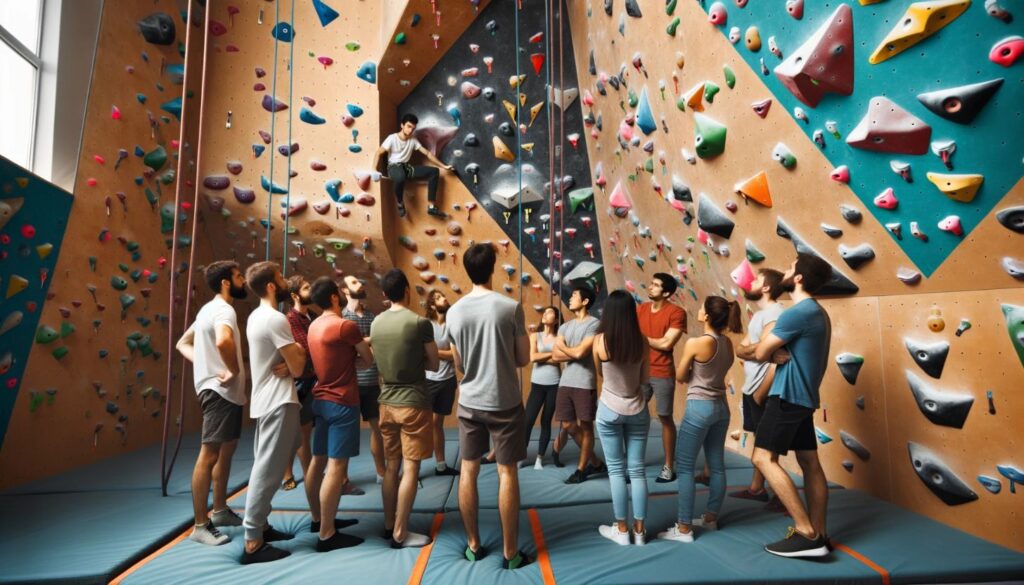
Overcoming Challenges
Indoor climbing for beginners can present both mental and physical challenges that may seem daunting at first. However, with the right mindset and approach, you can overcome these obstacles and make significant progress in your climbing journey.
Mental Challenges
One of the biggest mental challenges beginners may face is fear. Fear of falling, fear of heights, fear of failure – all of these can hold you back from reaching your full potential. The key to overcoming fear is to acknowledge it and work through it. Start by taking small steps and gradually pushing yourself out of your comfort zone. Remember to breathe and focus on the present moment, rather than worrying about what could go wrong. Surround yourself with supportive and encouraging people who can help you build confidence and stay motivated.
Physical Challenges
As a beginner, it’s natural to experience muscle soreness and fatigue after your first few climbing sessions. However, this doesn’t mean you should push yourself to your limits every time you climb. Rest and recovery is just as important as training. Make sure to stretch before and after each session, and incorporate rest days into your schedule to give your body time to heal and rebuild.
Remember that progression takes time and dedication. Don’t be discouraged by setbacks or slow progress – focus on the small victories and celebrate each step forward. With perseverance and a positive attitude, you can overcome any challenges that come your way and become a confident and skilled indoor climber.
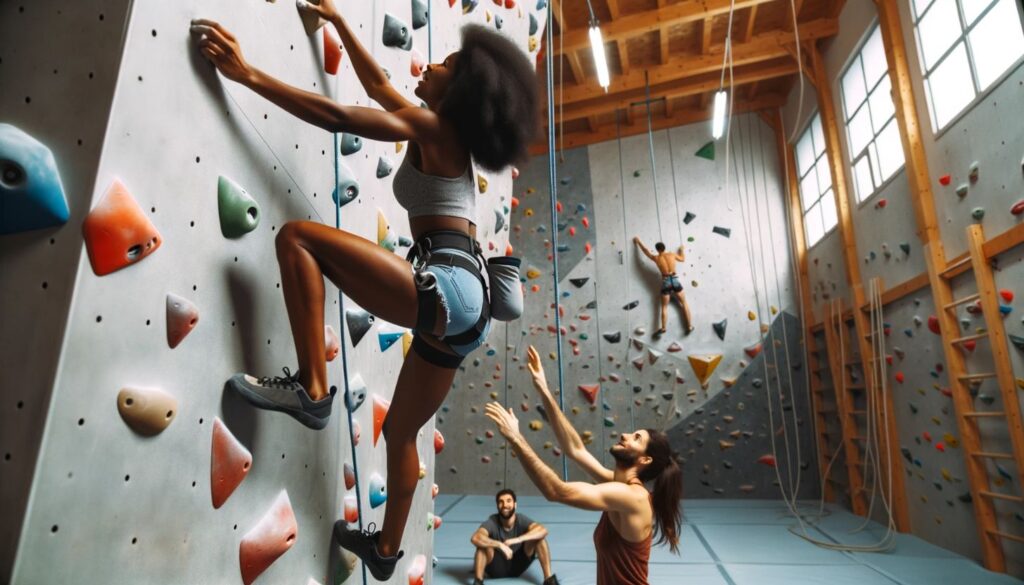
Progression Tips for Indoor Climbers
Indoor climbing is a fun and challenging activity that can help you build strength, endurance, and confidence. As a beginner, there are many ways to progress and improve your skills so you can tackle more challenging routes and goals. Here are some tips on how to progress in indoor climbing:
- Set goals: Whether it’s to climb a certain grade or complete a specific route, setting achievable goals can help motivate and track progress. Make sure your goals are realistic and challenging but also attainable with hard work and practice.
- Cross-train: Supplement your climbing workouts with other forms of exercise that can help build strength and improve flexibility. Yoga, weightlifting, and cardio can all help support your climbing abilities.
- Track progress: Keep a journal or log of your climbing sessions to help track progress and identify areas for improvement. Note the types of routes you climbed, any challenges you faced, and what you learned from each session.
- Try new challenges: Don’t be afraid to try new routes and challenges as your skills improve. Pushing yourself out of your comfort zone can help you continue to grow and improve.
Remember, climbing is a journey that requires patience, hard work, and dedication. Celebrate your progress and enjoy the process as you become a better climber.
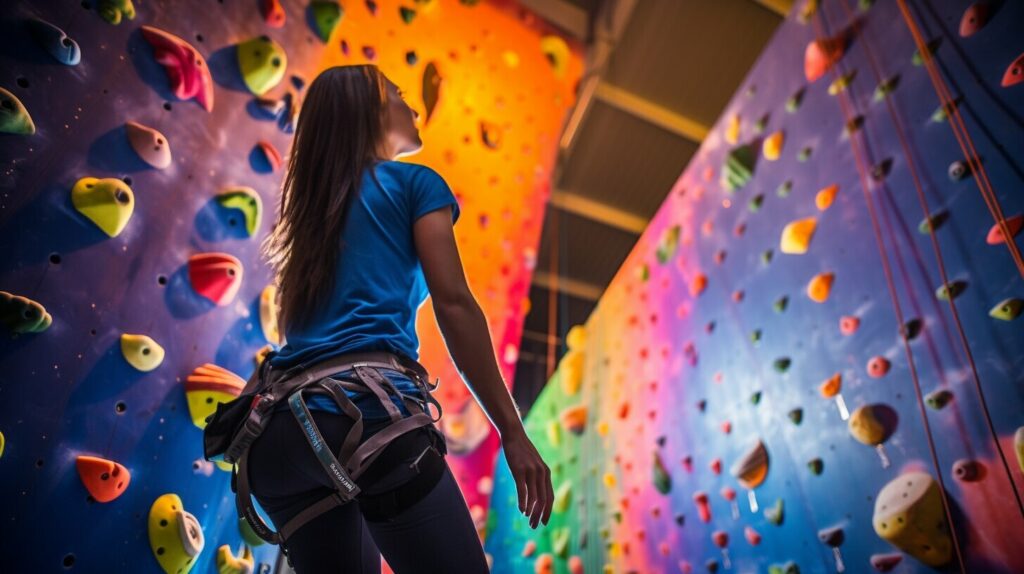
Conclusion
Overall, indoor climbing is a excellent way for beginners to get started in the sport of climbing. With its controlled environment and supportive community, it offers a safe and accessible way to develop your skills.
To get the most out of your indoor climbing journey, it’s important to prioritize safety. Remember to always check your equipment before climbing, communicate effectively with your belayer, and follow the rules and etiquette of the gym.
Additionally, incorporating indoor climbing exercises into your routine can help you improve your strength and technique. Some exercises to try include hangboarding, finger curls, and core exercises like planks and leg raises.
Keep Learning and Growing
As a beginner climber, it’s important to focus on progress and growth. Set goals for yourself and track your progress over time. Consider taking indoor climbing classes or seeking out new challenges to continue improving your skills.
Remember that climbing is both a physical and mental challenge. Don’t be afraid to step out of your comfort zone and overcome any fears or doubts that may arise. Trust in yourself and the support of the climbing community to help you achieve your goals.
So what are you waiting for? Start your indoor climbing journey today and see where it takes you!
FAQ
Why should beginners choose indoor climbing?
Indoor climbing is a great option for beginners because it offers a controlled environment, safety measures, and accessible learning opportunities. It allows beginners to learn and practice climbing techniques in a safer and more controlled setting compared to outdoor climbing.
What gear is essential for indoor climbing beginners?
Essential gear for indoor climbing beginners includes climbing shoes, harnesses, belay devices, and chalk bags. These items ensure safety and provide the necessary tools for climbing effectively. It is important to have properly fitting gear to enhance performance and reduce the risk of injury.
How do I choose the right indoor climbing gym as a beginner?
When choosing an indoor climbing gym as a beginner, consider factors such as location, facilities, routes, and instructional offerings. Look for gyms that have beginner-friendly routes, knowledgeable staff, and a welcoming environment. Visiting different gyms and talking to fellow climbers can also help in making the right choice.
What are some safety tips for indoor climbing beginners?
Safety is paramount in indoor climbing. Some safety tips for beginners include properly warming up and stretching before climbing, communicating effectively with belayers, checking equipment before each climb, and familiarizing yourself with the gym’s rules and etiquette. It is important to prioritize safety at all times and seek guidance from experienced climbers if needed.
What are some indoor climbing techniques for beginners?
Beginners can start by learning basic movements, proper footwork, handholds, and body positioning. Focus on developing good technique and efficiency in climbing. Practicing fundamental climbing techniques will help improve skills and increase confidence on the wall.
Are there specific indoor climbing routes suitable for beginners?
Yes, there are indoor climbing routes specifically designed for beginners. These routes usually have lower difficulty ratings and are ideal for practicing and building foundational climbing skills. It is recommended to start with easier routes, gradually increasing the difficulty as abilities improve.
Are there indoor climbing classes for beginners?
Yes, many indoor climbing gyms offer classes designed specifically for beginners. These classes provide structured instruction, guidance, and feedback from experienced climbers. Taking indoor climbing classes can accelerate learning, improve technique, and offer a supportive community for beginners.
What exercises can help beginners improve their indoor climbing abilities?
Strength-building exercises, such as pull-ups and core exercises, can help improve overall climbing abilities. Finger and grip strength exercises are also essential for indoor climbing. Additionally, incorporating general fitness activities such as cardio and flexibility training can enhance overall performance.
How can beginners overcome mental and physical challenges in indoor climbing?
Beginners can overcome mental challenges in indoor climbing by gradually pushing their comfort zones, setting achievable goals, and practicing visualization and positive self-talk. To address physical challenges such as muscle soreness and fatigue, adequate rest, proper nutrition, and cross-training activities can aid in recovery and overall improvement.
How can beginners progress in indoor climbing?
Beginners can progress in indoor climbing by setting realistic goals, tracking their progress, and seeking new challenges. Incorporating cross-training activities, exploring different climbing techniques, and gradually increasing the difficulty of climbing routes can help beginners continue to improve and enjoy the sport.

